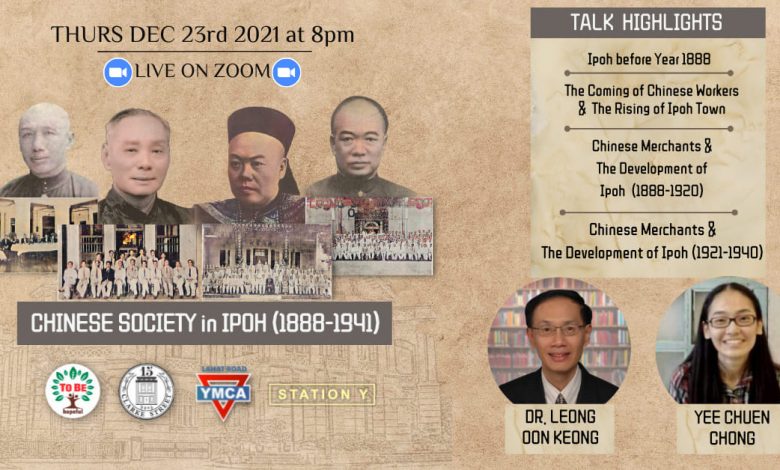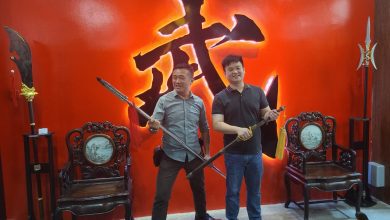

Lahat Road YMCA, in joint collaboration with To Be, Clarke Street and Station Y, recently organised an online talk on the history of the Chinese society in Ipoh from the year 1888 to 1941. It was hosted by Dr Leong Oon Keong, with Chong Yee Cheun as the main speaker.
Chong, who currently works as a Chinese teacher in an independent high school, graduated with a degree in Chinese studies in UTAR, Kampar in 2011. She then undertook a History degree in the National Taiwan Normal University in 2013, with research focused on the history of Malaysian Chinese.
“These 50 years (1888 to 1940) show how Ipoh transformed from a village to a town. The Chinese community played an important role in this transformation,” she said in her introduction into the topic.
Quoting the book, ‘Ipoh: The Town that Tin Built’, Chong explained that Ipoh was little more than a small market village with only a couple hundred inhabitants in 1884. An Annual Report by Major R.F Walker stated that Kinta District had nearly 2,000 Chinese inhabitants by 1888, a year which Chong pointed out was the turning point for Ipoh.
Chong then discussed the factors that transformed Ipoh from a small village into a town, namely the establishment of the British Colonial Government that led to the development of transportation and communication facilities, and the rich tin deposits in Kinta that attracted tin miners from other districts and states. According to the Perak Government Gazette, 24,286 out of 26,023 tin mining workers in Kinta District were Chinese in 1891.
There were three prominent Chinese figures when it came to the development of Ipoh between 1890 to 1920, whom Chong referred to as the “pioneers”. They were the merchants Yau Tet Shin, Leong Fee and Foo Choo Choon.
Yau Tet Shin arrived in Ipoh around 1885 and established Chop Tat Foh, besides owning mines in Ampang and Kinta. His major contributions include founding Ipoh New Town, establishing Yuk Choy school and Min Tet primary school, as well as organising the Perak Chinese Chamber of Commerce alongside Foo Choo Choon.
Leong Fee, also known as Leong Pit Loo, was a clerk before he became a successful miner by the late 1880s, opening his own Tambun Mine in 1902. He was a member of the Perak State Council in 1897 and the only Chinese member of the Council of Federated Malay States in 1910. Through these posts, he was able to act as a bridge between the Chinese community then and the British government. His other achievements include building and expanding the Paloh Khoo Miu along the Kinta River and the establishment of Han Chin Pet Soo, a club for Hakka miners.
Foo Choo Choon moved to Ipoh in 1887 and opened tin mines at Lahat Hill and Tronoh, which later earned him the title “King of tin mines”. He was one of the founders of the Perak Hokkien Association and later held a role there as the President. He also held a post as the Chairman of the Perak Chinese Chamber of Commerce from 1913 to 1920. Similar to Leong Fee, he was eventually appointed as a member of the Perak State Council and was part of the Council of Federated Malay States after the passing of Leong Fee.
Chong later expanded on who she referred to as the “second generation” of prominent Chinese figures when it comes to the development of Ipoh around the period of 1921 to 1940. Due to time constraints, the main focus of this segment was Leong Sin Nam.
When he arrived in Ipoh, Leong Sin Nam first worked in Leong Fee’s tin mines in Tambun before eventually coming to own Pusing Mine, Falim Mine and Ampang Mine. He was the President of Perak Kaying Association in 1915, as well as the second president of the Perak Chinese Chamber of Commerce after Foo Choo Choon. In 1926, he was elected the President of the Perak Chinese Maternity Association, and later from 1937 to 1939, he helped build the Ipoh Chinese Assembly Hall.
In 1920, Leong Sin Nam was appointed as a member of the Perak State Council (after the passing of Foo Choo Choon) as well as the Perak Chinese Advisory Board. Nine years later, he was awarded the Malayan Certificate of Honour (M.C.H) by Sir Hugh Clifford (High Commissioner of the Federated Malay States) through a recommendation by the Sultan of Perak.
“As a small village and a rich tin mine, Ipoh had an enabling and supportive environment for Chinese merchants to start and develop their tin-mining business. When these Chinese merchants succeeded in their business, they used their resources to help develop Ipoh,” Chong explained. “I think that Chinese merchants were also representatives and leaders of the Chinese community in Ipoh—or even Kinta district and the state of Perak as a whole—in communicating with the British government.”
The talk concluded with a brief Q+A session between Chong and the attendees, followed by a polls review, a short video of Lahat Road YMCA, as well as a feature on the NGO of the month by the association.
To know more about the Life of Leong Sin Nam, interested readers can download the ebook “A Grandfather Story” written by Lahat Road YMCA’s Dr. Leong Oon Keong, who is a descendent of Leong Sin Nam. It is currently available free of charge through the use of a promo code until 1 January 2022. Below are the steps to download the ebook.
- Visit https://www.leong.my/books
- Choose “A GrandFather Story”.
- Select “Add to cart”.
- Select “View Cart”.
- Click on “Enter a promo code” and type in TOBE2021 .
- Check out.
Readers can also watch a replay of the talk on the Facebook page of Lahat Road YMCA. Follow them for more updates on future talks and programmes.
To read more about the Chinese pioneers in Ipoh, readers may also refer to this article by Ian Anderson.
Jia Huey
=============================
Get your local news fast. Download the Ipoh Echo App on your mobile. Available on both Google Playstore and Apple Appstore.







